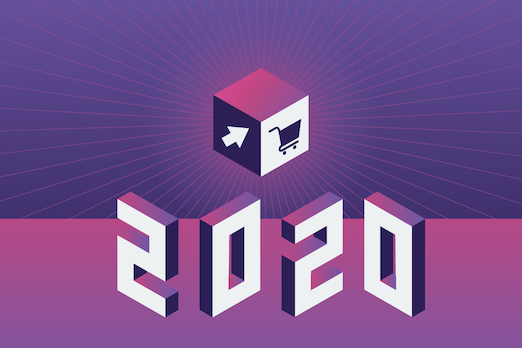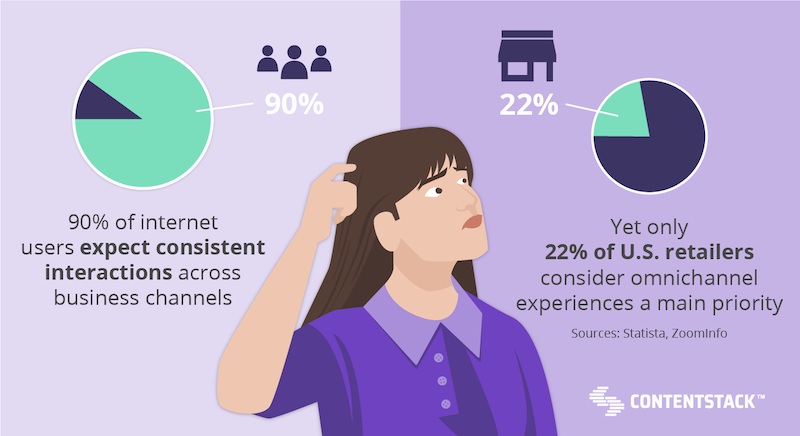5 Must-Know Digital Commerce Trends for 2020 and Beyond

People are talking to personal shopping robots, storefronts are morphing to mirror passers-by, and consumers are using hand-held computers to digitally try on clothes from the comfort of their own homes. It’s not science fiction—it’s a reality in the year 2020.
In this piece, we’ll explore the futuristic-sounding technology described above, evolutions in traditional operational models, and other digital commerce trends that will present significant opportunities for the digital retailers that take advantage of them in 2020 and beyond.
5 Must-Know Digital Commerce Trends for 2020 and Beyond
With some trends you know, such as omnichannel shopping, and some that may surprise you, for example, advertising is going to change—here are five digital commerce trends you absolutely must prepare for to survive and thrive in 2020 and beyond.
Options for Shopping Channels and Devices Will Continue to Grow
Omnichannel retailers use technology to tie together shopping channels to “…create a unified shopping experience across every single device and channel that a consumer uses to interact with their business.”
This approach to retail provides consumers with a seamless and continuous flow at every touchpoint (from social ads to mobile ecommerce sites to in-store kiosks) with which they interact when they’re researching or making a purchase from a business. And, omnichannel retail product and content delivery is practically a requirement for brands that want to remain modern and competitive.

The average digital consumer has five profiles across various online channels. And the majority of them expect consistent interactions across every profile they use to shop and interact with retailers.
What’s more, omnichannel shoppers spend an average of 4% more on every in-store shopping trip and 10% more online! Compared to single-channel shoppers, omnichannel shoppers visit their favorite retailers’ 23% more often and have a 30% higher lifetime value. Yet, 55% of shoppers still say their retail experience is “disjointed” when switching between channels, and only 22% of North American retailers consider omnichannel retail a priority.
There is a significant disconnect between today’s shoppers and retailers—which presents a critical opportunity for ecommerce businesses that can provide seamless products, content, and experiences across channels.

A headless content management system (CMS) like Contentstack is the answer to making omnichannel ecommerce possible by empowering retailers to create content just once and publish it everywhere.
Because a headless CMS has no built-in front-end system that determines how or where content will be displayed, content managers can serve consistent content experiences across websites, apps, chatbots, connected home devices, voice assistants, and more.
And thanks to an API-first architecture, Contentstack and other modern headless systems can easily integrate with API-powered ecommerce platforms, such as commercetools, to create robust, scalable ecommerce sites that are always up-to-date and ready for whatever the future of digital commerce holds.
Shoppers Will Use Augmented Reality to “Interact” With Digital Products
Augmented reality (AR) technology enables shoppers to use cameras on their smart devices to display digital elements in the physical world. And digital commerce brands like IKEA and Converse are setting the standard for how brands can take advantage of AR to enable their shoppers to get a “feel” for products before purchasing them online—saving everyone a lot of time, money, and headache.
IKEA enables shoppers to use their smartphones to virtually “place” furniture in their homes so they can visualize how certain products will fit into their space before making an expensive commitment. Converse’s smartphone app helps shoppers virtually try on shoes and share their cool, AR-enhanced kick pics on social media! AR is big business in the retail space—and there are numerous tools on the market (IKEA uses ARKit, for example) for digital commerce brands that are ready to get in on the new revenue stream.
Facial Recognition and Device Tracking Will Become the Norm
In 2020, retail businesses will hone in on omnichannel marketing and sales by integrating data gathered in-person with online customer profiles. This type of tracking is possible using radio frequency identification (RFID)-enabled beacons and WiFi to track devices, sensors to monitor movement, and cameras and facial recognition software to identify specific consumers. Retailers will finally be able to understand how shoppers interact with their physical stores the same way they use analytics tools to tell what’s happening in their digital ones!
Bringing together web, mobile, social, and now in-person data will put retailers in a position to provide 360-degree customer experiences in 2020. Take the eyewear retailer BonLook, for example. Thanks to smart cameras and sensors, they can tell you how many glasses-wearing women in their target age range walked by any one of their shops, at any given time, on any given day. Furthermore, they can break down how many of those people came into the store and how many completed a transaction. Using this information, BonLook was able to grow their conversions overnight just by updating their storefront advertising to better appeal to the group of passers-by whom they wanted to convert. With results like that, what retailer with brick-and-mortar stores wouldn’t want to try out fascinating new tracking technology?!
The Advertising Model Will Morph Into Something New
When you think of digital commerce advertising, chances are you think of Google, Amazon, and the big social media networks like Facebook, Instagram, YouTube, and so on. And you’d be right, considering that Google and Facebook combined take in 61% of all digital advertising spend in the U.S., on average.
Over $270 billion was spent globally on digital ads in 2018 alone. Americans are exposed to between 4,000 and 10,000 advertisements every single day—and at least 75% of them engage in at least one form of ad-blocking. Consumers are (understandably) overwhelmed, jaded, and less and less likely than ever to click on traditional, “interruption-based” ads.
That’s why, in 2020 and beyond, we’ll see advertising become more non-traditional, experiential, and naturally embedded in everyday experiences. Just look at Procter & Gamble’s Bare Skin Chat YouTube series, which features relevant celebrities in entertaining videos that are both engaging and informational—and has millions of views. In 2020, it’s time to create digital commerce advertising experiences that consumers want!

Voice-Based Digital Commerce Will Generate Billions
If you weren’t sure whether or not smart speakers were a passing trend, look at the most prominent players in the market—Apple’s Siri, Amazon’s Alexa, and Google’s Assistant. If the tech giants are investing, you know it’s time you should too.
In 2018, there were 2.5 billion voice-enabled devices. Predictions are that by 2023 there will be 8 billion of them. By some estimates, as many as half of all searches may be done by voice in 2020. And how about the voice-powered shopping market, specifically? Estimates are that the market is going to exceed $40 billion by 2022. If you are not optimizing the products and content on your website or app for voice search, make 2020 your year to upgrade.
Will You Invest in These Digital Commerce Trends for 2020?
Your level of investment in the trends we discussed today will help determine if your digital commerce business can succeed as the new decade breeds increasingly-capable technology and increasingly-savvy consumers.
A flexible and scalable CMS in place empowers you to keep up with growing shopping channels and devices. For example, AR app integration that allows shoppers to interact with your digital products, facial recognition and smart software gathering in-person data, a new and more natural advertising strategy, and optimizing content and products for the billion-dollar voice-shopping industry. By investing in these digital commerce trends, you won’t just be ready to survive in 2020—you’ll be prepared to thrive.
About Contentstack
The Contentstack team comprises highly skilled professionals specializing in product marketing, customer acquisition and retention, and digital marketing strategy. With extensive experience holding senior positions at renowned technology companies across Fortune 500, mid-size, and start-up sectors, our team offers impactful solutions based on diverse backgrounds and extensive industry knowledge.
Contentstack is on a mission to deliver the world’s best digital experiences through a fusion of cutting-edge content management, customer data, personalization, and AI technology. Iconic brands, such as AirFrance KLM, ASICS, Burberry, Mattel, Mitsubishi, and Walmart, depend on the platform to rise above the noise in today's crowded digital markets and gain their competitive edge.
In January 2025, Contentstack proudly secured its first-ever position as a Visionary in the 2025 Gartner® Magic Quadrant™ for Digital Experience Platforms (DXP). Further solidifying its prominent standing, Contentstack was recognized as a Leader in the Forrester Research, Inc. March 2025 report, “The Forrester Wave™: Content Management Systems (CMS), Q1 2025.” Contentstack was the only pure headless provider named as a Leader in the report, which evaluated 13 top CMS providers on 19 criteria for current offering and strategy.
Follow Contentstack on LinkedIn.







.svg?format=pjpg&auto=webp)
.svg?format=pjpg&auto=webp)
.png?format=pjpg&auto=webp)






.png?format=pjpg&auto=webp)


